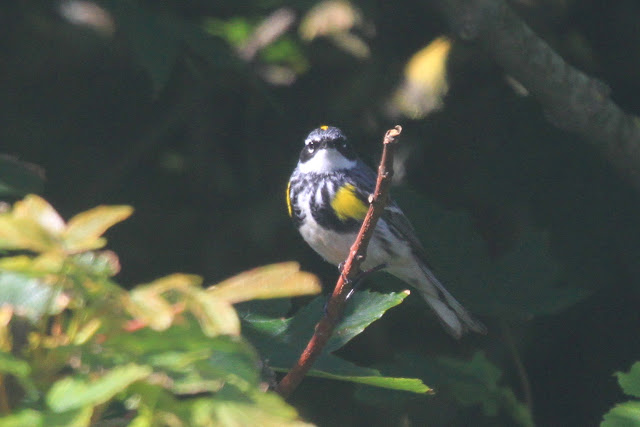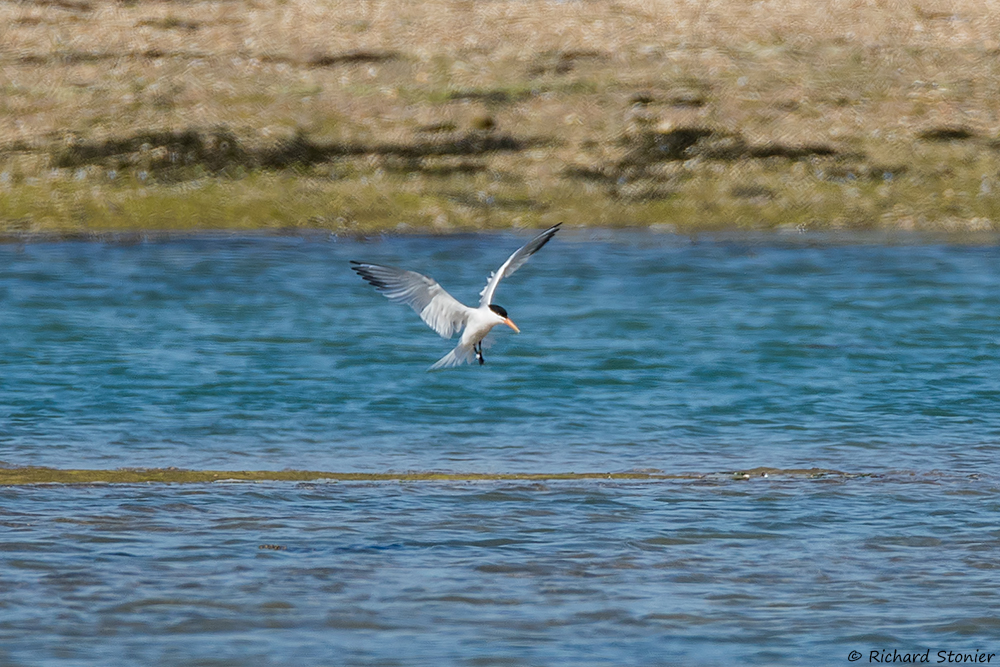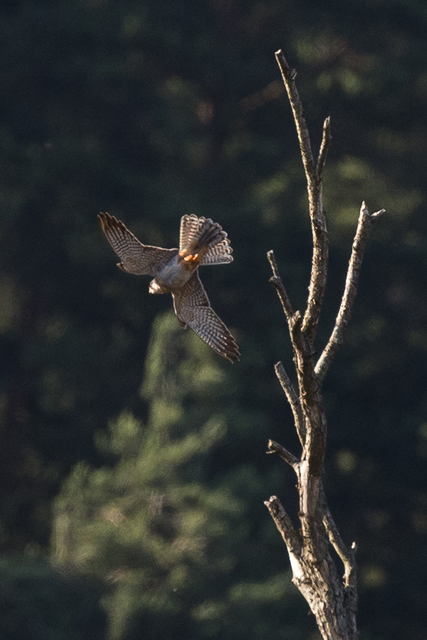The week at a glance
- Yellow-rumped Warbler on Skokholm, Pembrokeshire
- Elegant Tern still in West Sussex
- Caspian Tern in Lancashire
- Grey-necked Bunting in Germany
Given the truly sweltering summer weather, these past few days could easily have been a languid affair but the birding world continued to sparkle, not least through mostly vicarious enjoyment of a completely unheralded and totally dazzling North American passerine on a certain Welsh island. We have grown used to the occasional Nearctic landbird randomly popping up over the summer months, but it is seldom something so ravishing as the male Yellow-rumped Warbler that sang and flitted about the courtyard on Skokholm, Pembrokeshire, on Sunday. It being the 22nd British record was an irrelevance as gripping photographs emerged and boats were arranged for the afternoon and the following day. Nine birders made the Sunday boat and successfully latched eyes on the colourful waif, which later ended up in the island's Heligoland trap before slipping away over a clear night. With fresh and sweet memories of the popular Swainson's Thrush that graced the same elder bush in June 2015, Skokholm's courtyard is fast becoming hallowed turf.

Yellow-rumped Warbler, Skokholm, Pembrokeshire (Photo: Richard Brown)
Aside from the warbler, it was the Elegant Tern in Pagham Harbour, West Sussex, that continued to steal the show, performing well in flight around the tern colony near Church Norton until 18th. There were conflicting reports regarding its presence or otherwise the next day and it looked as though it might have bailed out and returned to its usual French haunts — but the early evening of 20th saw it drop in again. Quite why it suddenly changed its habits is a bit of mystery but perhaps it needed to rethink its feeding tactics after running short of luck pirating fish from its Sandwich Tern neighbours. The Elegant wasn't the only bright-billed tern this week, with a fine adult Caspian Tern paying two brief visits to Holden Wood Reservoir, Lancs, on 20th, before flying through Leighton Moss later in the day.

Elegant Tern, Pagham Harbour LNR, West Sussex (Photo: Richard Stonier)

Caspian Tern, Holden Wood Reservoir, Lancashire (Photo: Sarfraz Hayat)
In a touch of eastern flavour, Foula, Shetland, turned up its second Black-headed Bunting of the year, with a female at the brilliantly named Harrier on 15th. Fair Isle produced a male Rustic Bunting on 14th and Greenish Warblers were discovered on Colonsay, Argyll, on 15th and at Landguard, Suffolk, on the afternoon of 20th.
The honour of the first Cory's Shearwater of the season went to Lizard Point, Cornwall, past which one flew on 19th. However, the seabird season is yet to kick off in full, an indicator being a total of just four Balearic Shearwaters, split equally between 15th and 20th at Portland, Dorset. Somewhat off-grid, but a further source of encouragement for the reason to come, a Wilson's Storm Petrel was seen from a research vessel 136 km south of Cape Clear, Co Cork, on 17th.
Established stars in the northern half of the country included the gorgeous adult summer Spotted Sandpiper at Buttermere, Cumbria, and the vocal Pied-billed Grebe at Loch Feorlin, Argyll, both to 19th, while Strontian's American Black Duck, Highland, was reported on 16th. Before venturing to the beach at Blackdog on 20th, the resident adult drake King Eider had continued to loaf on the Ythan Estuary, Aberdeenshire. Loch Finlaggen on Islay, Argyll, held onto its drake Ring-necked Duck to 19th and the female Surf Scoter was present and correct on Echna Loch, Burray, Orkney, on 20th.

Spotted Sandpiper, Buttermere, Cumbria (Photo: Baz Scampion)

Surf Scoter, Echna Loch, Burray, Orkney (Photo: Ian Cunningham)
Initially reported as a Marsh Warbler, but its true identity soon realised, a Blyth's Reed Warbler was a great turn out for the county at Siddick Ponds, Cumbria, from 14–15th, as it belted out its song from open perches. Meanwhile, the Marsh Warbler maintained territory at Bowesfield Marsh, Cleveland, throughout and others were in voice at Minsmere, Suffolk, on 17th then at both Beeston Common, Norfolk, and Fair Isle on 18th. Two were seen on Foula, Shetland, on 14th. Cheshire's Iberian Chiffchaff at Tirley Hollow near Kelsall sang all week but proved elusive at times. Minsmere continued to buzz with the sound of the Savi's Warbler at Island Mere to 19th, with two reported there the next day, but the Wicken Fen bird went quiet after 18th. Highland's Icterine Warbler was still in voice at Nigg Bay on 19th and another was on Fair Isle on 18th.

Blyth's Reed Warbler, Siddick Ponds NR, Cumbria (Photo: Roy Atkins)

Marsh Warbler, Bowesfield Marsh, Cleveland (Photo: Chris Downes)
In the land of the herons, on the Somerset Levels, Ham Wall's barking male Little Bittern was present to the end of the week and there was a brief treat nearby in the form of an adult Purple Heron at Meare Heath then Shapwick Heath on 15th. Another Purple Heron, a first-summer, made paid a brief visit to Potteric Carr, South Yorkshire, on 14th. An adult Night Heron slinked around Cosmeston Lakes, Glamorgan, from 18–19th, while a second-summer arrived at Rogerstown, Co Dublin, on 18th and the hoactli bird performed for the cameras in Shewsbury's Dingle Gardens, Shropshire, to at least 19th. At Burton Mere, Cheshire, the Cattle Egret nest was the reserve's main attraction and others were knocking around Gloucestershire, Lincolnshire, Norfolk, Devon and Somerset. Two Glossy Ibis south over Mere, Wiltshire, on 19th was a tidy record, while the faithful duo roamed Ham Wall.

Night Heron, Cosmeston Lakes CP, Glamorgan (Photo: Colin Harvey)
This year's plenitude of Red-footed Falcons was sustained by seven new, and all rather slippery, individuals, their roving facilitated perhaps by the sultry conditions. Of these, males were seen over Wellington, Somerset, on 14th; Somerleyton, Suffolk, on 17th; Wadebridge, Cornwall, on 19th and Worth Marsh, Kent, on 20th. The new females were sighted at Caldwell, North Yorkshire, on 15th; Breydon Water, Norfolk, on 16th; Morden Bog, Dorset, on 18th and Fowlmere, Cambridgeshire, on 20th. The only bird which was pinned down to any extent was the long-staying first-summer male at Frensham Common, Surrey, which seemed eventually to have taken its leave in the early morning of 19th. On 18th, Ham Wall's first-summer female made a fleeting and distant return, perhaps feeding somewhere unknown nearby. Norfolk's immature White-tailed Eagle emerged from the ether over Langley Green, Chedgrave, on 17th and a migrant ringtail Montagu's Harrier drifted through Porlock Marsh and Hurlstone Point, Somerset, on 19th, with possibly the same bird seen in the Quantock Hills the following day.

Red-footed Falcon, Frensham Common, Surrey (Photo: James Sellen)
Poole Harbour's Lytchett Fields, Dorset, produced another fine result in the form of a Buff-breasted Sandpiper on 15th, but it didn't hang around for long. Further north, on 19th, an adult White-winged Black Tern was an excellent Outer Hebrides record on Benbecula. Pairs of Red-necked Phalaropes were off Noss and Mousa, both Shetland, on 18th but a lone bird at Attenborough NR, Notts, on 20th was a little more out of the blue. A steady supply of charm was offered by the Black-winged Stilt families at Potter Heigham Marshes, Norfolk, and the Ouse Washes, Cambridgeshire, throughout the week.

Black-winged Stilt, Ouse Washes RSPB, Cambridgeshire (Photo: Dennis Morrison)
Late Woodchat Shrikes were on Sanday in Orkney and on Fair Isle on 16th, while a vague report emerged from Lundy, Devon. It's been lean pickings as far as Red-backed Shrikes are concerned this year but a stonking male posed well for the cameras at Blakehill Farm, Wiltshire, on 16–17th and a one-day female at Bempton Cliffs on 18th attracted a few admirers, while another male was on the island of Arran on 16th. An unseasonable Red-rumped Swallow appeared at Ponsongath, Cornwall, on 17th and the Hoopoe resurfaced at Ballyferriter, Co Kerry, on 13th.

Red-backed Shrike, Blakehill Farm NR, Wiltshire (Photo: Dave Soons)
The south coast registered a light smattering of lone European Bee-eaters, starting with birds over Durdle Door, Dorset, and Foreness, Kent, on 15th. Another bubbled away over the classic spot of Dungeness, Kent, on 17th before Warnborough, Hants, bagged one on 19th. Buckton, East Yorkshire, attracted a popular singing first-summer male Common Rosefinch on 18th and another proclaimed itself in gardens at Southwell on the isle of Portland, Dorset, on 20th. June is the month for hearing this simple songster from the east, and further birds included two singers in just one Halligarth garden on Shetland on 18th and a lone bird near Crinan, Argyll, on 15th. Serins trilled over Portland on 15th, Baltimore, Cork, on 17th and Landguard, Suffolk, on 19th. A smart Rose-coloured Starling stayed in Stanhope, Co Durham, for only two days from 14th but enraptured local birders during its short visit.
The Bann Estuary, Co Derry, hosted a first-summer Bonaparte's Gull on 16th, which cropped up again on 20th. The first-summer Ring-billed Gull lingered at Lurgan Green, Co Louth, to 17th, while an intriguing report concerned an 'immature' Sabine's Gull at Lough Swilly, Co Dongal, on 18th. Tardy white-wingers included two Glaucous Gulls and four Iceland Gulls still on the Outer Hebrides, as well as other Icelands in East Yorkshire, Aberdeenshire, Shetland and Co Meath. Highland, Moray/Nairn and Co Kerry also held onto Glaucs.
Western Palearctic News
There was plenty of action around the region this week, starting in style with a tantalising record of a male Grey-necked Bunting, the third for Germany, at Hallige Hooge, Schleswig-Holstein, on 14th. The same day saw Poland's third Black-headed Bunting at Jastarnia on the Hel Peninsula, and a Swinhoe's Storm Petrel off Eilat, Israel, potentially representing the state's eighth record.
The first-summer American Royal Tern lingered at Langueux at Greves des Courses in Saint-Brieuc, Brittany, to 17th, while Germany's adult Black-browed Albatross at Rantumbrecken, Sylt, Schleswig-Holstein, remained lost to any intrepid urges, being logged there on 19th. On the same day a Trumpeter Finch, Norway's second, was seen at Breidvik, Hordaland, and a Rüppell's Vulture was at Col du Soulor, Pyrenees-Atlantiques, France. The finch was confirmed present again on 20th.

